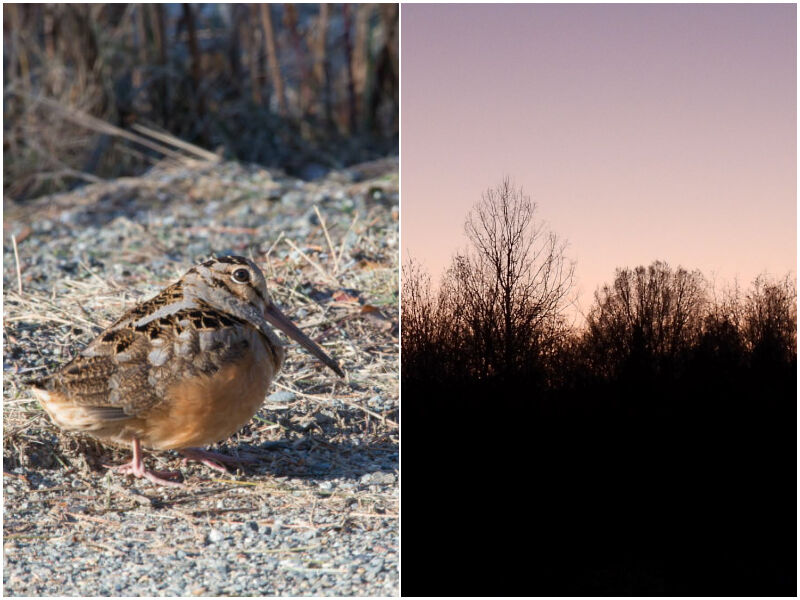Dusk was deepening in the alder brush of the Bibon Swamp as we tiptoed down the gravel road. Robins yakked from the trees and spring peepers yelled from the water much louder than our feet, but still we kept our breath and movement and thoughts as quiet as possible so as not to miss it.
Peent.
I heard it first, since I knew what to expect. I pointed eagerly toward a featureless place in the bushes. Peent. The brand-new birder with me strained to pick that one sound out of the thicket. Peent. We waited; breaths held. Peent. We wanted more.
At the next grassy opening along the road, we heard another peent. We paused, peering into the place where grasses met alders. Twittering sounds burst from the grass, and a flappy little flier rose in a broad spiral, soon clearing the treetops and circling up toward the crescent moon. Fatter than a robin, smaller than a grouse, the winged shape twittered ever higher into the navy blue. About 200 feet up, the twittering became sweet chirping, and the American woodcock sideslipped down like a falling leaf. Peent. Back on his dancing ground, the male began his courtship display again. Peent. My friend and I turned to each other, grinning.
Nature has invented some pretty interesting courtship behavior over the eons, and American woodcocks are a lovely example. Somewhere in the bushes, a female woodcock pretends not to watch the male’s strenuous antics. If he passes muster, she will let him approach her, bobbing with his wings raised, to seal the deal. That’s it, though. She goes off to build a nest and he keeps displaying.
Over a decade ago, in Maine, I spent another evening surrounded by woodcocks. The blueberry bald reminded me of Friar Tuck’s iconic haircut. Low shrubs and lichen-covered rocks dotted the top of the hill, with a shaggy forest forming a circle around the crown. As dusk fell, woodcocks peented and twittered and chirped in ethereal surround sound, as if in my own private Omnitheater. Private, except for an acquaintance who was not a birder. He stood by – bored – while I slowly spun in circles, high on the wonderment of nature.
Fast forward a couple years to my closest encounter with a woodcock. His peent buzzed right through the thin nylon of my tent wall. When I sat up in my sleeping bag to look out of the mosquito netting, his funny shape was just a few feet away, strutting on the packed dirt of the campground. I could see the silhouette of the woodcock’s three-inch-long bill open with each peent. Absolutely thrilled, I poked my tent mate so that he wouldn’t miss this cool experience. Grumbling about the noise, he pulled his sleeping bag up over his ears.
Like people, woodcocks’ peculiarities are what make them fun to get to know. For example, they have some great nicknames: timberdoodle, Labrador twister, and bog sucker top the list. And their oddly fantastic attributes don’t stop there. Sure, having big eyes on the top of a pointy head looks like a badly drawn cartoon, but that gives woodcocks the ability to see danger in any direction. Probing the mud for food with a super long bill doesn’t seem like elegant dining, except that using their flexible, sensitive bill tip, woodcocks can both perceive a worm and grab it, all underground.
Woodcocks can even dance! Stepping one foot forward, they’ll bob their body rhythmically while their head stays eerily still, then take a step and bob again. TikTok has discovered all the pop music with just the right beat to match the woodcock’s moves. Scientists aren’t sure why woodcocks do this funny walk, but stirring up earthworms for easier feeding is one hypothesis.
Food wasn’t their priority under the crescent moon last week. The peents came from both sides of the gravel road. The beginner birder and I listened to a particularly loud male call for a few minutes, and when he took to the air, we stumbled forward over grassy hummocks to get closer to where we’d thought he’d been. When his twitters turned to chirps, we crouched low and tried to become invisible. Peent. No luck, he’d landed behind us.
It didn’t matter. Grinning in the darkness, we talked about all the amazing events of the evening on our way back to the car. I’m not sure what traits woodcocks are looking for in a partner, but I want to hang out with someone who goes looking for woodcocks!
Emily’s award-winning second book, Natural Connections: Dreaming of an Elfin Skimmer, is available to purchase at www.cablemuseum.org/books and at your local independent bookstore, too.
For more than 50 years, the Cable Natural History Museum has served to connect you to the Northwoods. The Museum is closed until May 1 to construct our new exhibit: “Anaamaagon: Under the Snow.” Our Summer Calendar of Events is open for registration! Follow us on Facebook, Instagram, YouTube, and cablemuseum.org to see what we are up to.
Last Update: Apr 24, 2024 8:57 am CDT
















